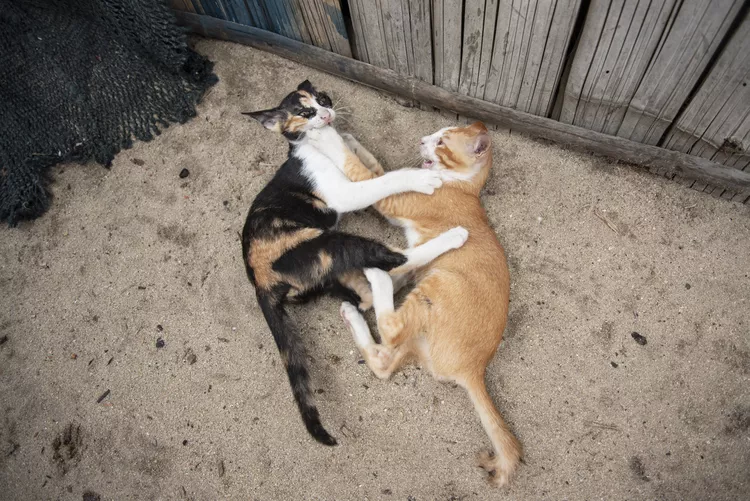How to Stop Cats From Using a Sandbox as a Litter Box

If cats are using your child's outdoor sandbox as a litter box, then you have a few options for stopping the behavior. For instance, you can put up a barrier, use cat deterrents, or consider keeping your cat inside if your cat is the culprit. It's not an easy task, but the one thing you don't want to do is ignore the problem because it can pose a danger to the children who play in the sandbox.
Why Do Cats Use a Sandbox as a Litter Box?
In the wild, cats naturally excrete in soft or sandy soil to facilitate easy burial. They use their paws in a backward sweeping motion to cover their feces. In the backyard, the sandbox is a natural outlet for this instinct in cats who pass through or hang out in your yard. It isn't that much different from your cat's indoor litter box.
If you don't stop cats from defecating in the sandbox, though, it can be harmful to people. During playtime, children may be exposed to parasitic diseases such as round worms and toxoplasmosis that can be carried in cat feces. Most cats that have parasites don't show any symptoms either. And even if your cat is healthy, you can't account for strays or your neighbors' outside cats that may be carrying these diseases.
How to Stop Cats From Eliminating in a Sandbox
While the cause behind this behavioral issue is simple, the solution isn't. Every cat is different, so you might have to try a few deterrents or combinations of deterrents before you find a solution that works in your situation. This is especially true if you're dealing with stray or neighborhood cats whose behavior you can't control.
Clean It Up
It's plain unsanitary and disgusting to have cat feces or urine in a sandbox that kids play in, and the odor may attract more cats to your yard. Clean it up ASAP by removing the contaminated sand, scrubbing the sandbox with a mixture of 3/4 cup household bleach to each gallon of water, and letting it dry completely before refilling it with fresh, clean sand.
Cover the Sandbox
The easiest solution to keeping cats out of your kid's sand is to make it a habit to cover the sandbox whenever children aren't playing in it.
A store-bought sandbox may come with a cover that's designed to keep rain and animals out when it's not in use. You can also fashion a homemade cover using wood, lattice or screening, or heavy outdoor fabrics.
Employ Sprinklers
Installing a device such as a motion-sensitive water sprinkler is another way to keep animals away. These are often used for gardens, so you can usually find them in the gardening section of hardware or big-box stores.
If you put a sprinkler right next to the sandbox, the cats will likely get the message. A disadvantage of this method is that, depending on the direction of the spray, it may also get the sandbox wet.
Use Natural Deterrents
There are several natural deterrents that you can use around the sandbox to discourage cats from entering. Any of these substances—either used alone or combined with others—can make for an anti-kitty cocktail that's not harmful to animals or people. You will, however, need to reapply them frequently as their potency fades due to rain, sun, and wind.
- Cats dislike the smell of vinegar, so try spraying a vinegar-water solution around the sandbox perimeter.
- They're not fans of citrus smells either. Save orange, lemon, or other citrus peels and scatter them around the sandbox.
- Cats also can't stand coffee grounds, so they can be sprinkled around the sandbox.
Spray Store-Bought Repellents
A variety of commercial sprays designed as cat repellents are also commonly used by gardeners. They contain preparations that are offensive to cats but not harmful to either cats or children. Do be sure to carefully read and follow the manufacturer's directions on the product label.
This type of spray may be effective when applied around the border of a sandbox. Rain and sunlight will dissipate the spray over time, so you'll need to reapply frequently.
Transition Your Cat to Indoor Only
If your cat seems to be the cause of the sandbox mess, you might need to transition it to being an indoor-only cat. To start the process, provide the cat with at least two litter boxes inside the house and train it to use them. The rule of thumb is one box per cat, plus one extra in the beginning. Once the cat is trained, you can drop down to one box.
Supervise Your Cat's Outdoor Time
If your yard is safe from your cats and predators and other cats can't get in, you can still let your cat outside periodically, but this will only work if you're able to supervise the cat at all times. You can even teach your cat ways to play outside; similar to their canine counterparts, some cats love to play fetch.
Whenever you notice your cat heading toward the sandbox, pick it up and move it elsewhere. Use your disciplinary tone and find some sort of distraction that's more tempting than the sand. Eventually, your cat will learn to stay away from the sandbox.